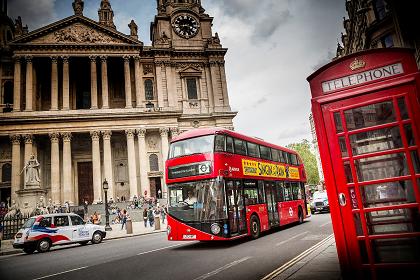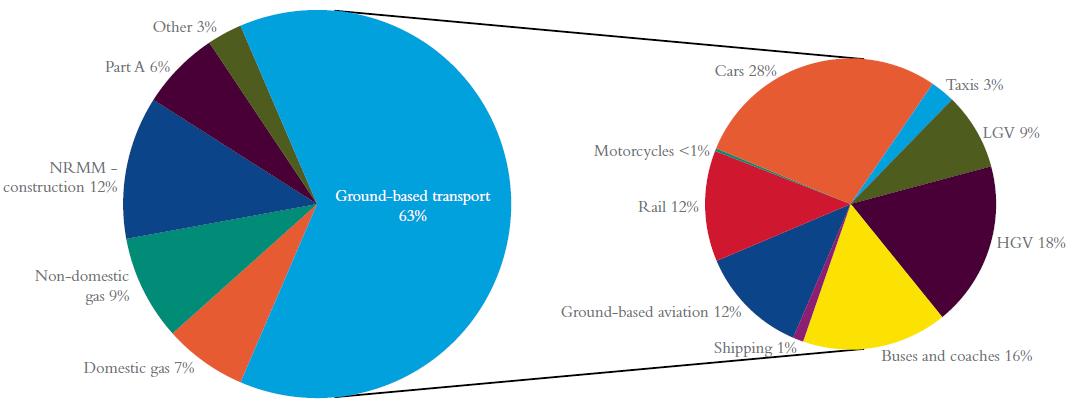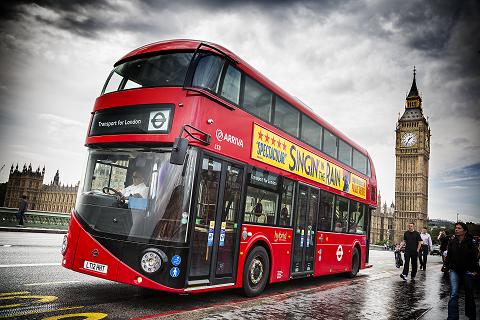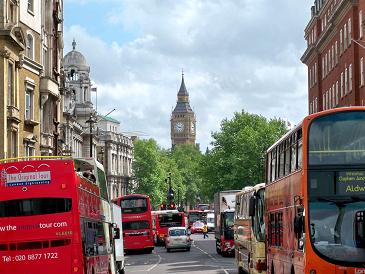Hybrid buses in London
TfL has responsibility for implementing the Mayor’s Transport Strategy (MTS). This strategy sets out the Mayor’s goals and expected outcomes for London to 2031. It is multi-dimensional, covering spatial policy and modal policies and proposals. The strategy sets out an integrated approach to improve the mode share for London’s sustainable modes of travel.
Whilst London’s air quality has improved in recent years, it is the worst in the country and emissions of two local air quality pollutants continue to pose a challenge. Particulate matter (PM10) levels now generally meet EU limit values whereas those for Nitrogen Dioxide (NO2) remain too high.
London’s air exacerbates heart and lung conditions such as asthma, particularly in children, older people and those with poor health and so significant intervention is needed to reduce exposure and improve Londoners’ health. Also, the Mayor of London Boris Johnson has a target to reduce London’s CO2 emissions by 60 per cent by 2025, which is significantly more ambitious than the national targets set by Government.
London is world leading in achieving an unprecedented shift in mode shares for travel away from the private car towards public transport, walking and cycling. There was a 9 percentage point net shift in journey stage based mode share between 2000 and 2011 towards public transport, walking and cycling. The MTS aims to continue to build on this. It also aims to reduce the negative impact of London’s transport system on London’s environment – setting out how emissions from transport should be reduced. Specifically it focuses on those emissions which are within the Mayor’s direct control or influence, taking a lead by promoting a cleaner public service fleet, including buses, taxis and Greater London Authority (GLA) group vehicles.
NOX emssions in London 2010
Innovation and ingenuity
London has long been the financial and political powerhouse of the UK with a reputation for innovation, invention and ingenuity. More recently, it has been turning its traditional red buses green including designing a unique hybrid double-deck vehicle for the capital to provide more sustainable public transport for the 21st century. The city currently has 8,700 buses operating across 700 routes, many of them 24 hours a day, delivering 6.5 million journeys a day, to reflect the demands of one of the most visited and multi-cultural capitals in the world. This number is made up of 440 hybrid buses that harness a combination of conventional diesel engines, electric motors and regenerative braking.
However, a step change is underway to raise the number of hybrid buses from the current number to 1,600 by 2016 – almost one in five buses in the fleet – with the help of mayoral policy and central Government support. The drive towards hybrid adoption comes from several compatible goals that have converged around the same time.
The Mayor made a commitment to return an iconic state-of-the-art 21st century successor to the famous Routemaster to the streets of London around the same time as the Government’s Department of Transport announced financial support for measures that would reduce emissions generally in the city.
The hybrid option for buses offers a highly cost effective and practical means for CO2 reduction and includes other benefits such as lower fuel consumption, noise and NOx emissions. Introduction of the first hybrids to London started with trials and evaluation in 2006 when a core of 56 vehicles from four different manufacturers were phased into service. Their satisfactory operational and environmental performance led to the hybrid fleet rising to 300 vehicles by 2012, then 430 by March this year, across more than 20 targeted routes.
Green Bus Fund
The pace of introduction has gathered momentum with the help of several grants, totalling £18 million, from the Department for Transport’s Green Bus Fund, and a mayoral commitment to return a 21st century Routemaster to the streets of London. TfL has just placed an order for 600 New Bus for London (NBfL) production vehicles from Wrightbus, of Ballymena, Northern Ireland, for introduction up to 2016 following trials of eight prototypes from 2012.
The first batch of production buses are currently being delivered to bus operator Metroline for conversion of route 24 which connects many popular tourist areas from Hampstead Heath to Camden, Trafalgar Square, Victoria and Pimlico. It will be the first route in the city to operate solely with this type of bus, 24 hours a day, from June this year.
The Mayor is due to announce a second route conversion in autumn as part of the next stage of the roll out to central London areas where the vehicles’ low emission and three-door boarding and alighting benefits will be of greatest benefit. The vehicle design is distinctive with a rounded back, open platform at the rear, two staircases and three doors.
The NBfL is easily the cleanest hybrid bus in the fleet and has been designed specifically with London in mind. When compared to an average diesel bus in the fleet, it emits around four times less NOx, almost half the CO2 and four times less particulate matter under the London Buses’ simulated route cycle. When all 600 vehicles are operating across the capital, the expected saving in CO2 will be almost 20,000 tonnes a year.
Both the NBfL and other types of hybrid procured by private bus operators from the open market are being deployed on routes within central London where pollution levels are known to be higher and can make a significant reduction in exhaust emissions.
In a separate initiative which seeks to achieve a 20 per cent cut in NOx from the bus fleet by 2016 compared to 2012 levels, TfL is retrofitting 900 Euro 3 buses from now to 2014 with selective catalytic reduction equipment which reduces exhaust NOx by up to 88 per cent in real-world conditions. The £10 million cost is being funded equally by TfL and the Government’s Department for Transport. A similar number of Euro 3 buses will also be phased out from 2014 and 2016 through the early renewal of route contracts. The new buses that replace them will have ultra-low emission Euro 6 engines which are anticipated to cut NOx by up to 95 per cent compared to a Euro 3 counterpart.
Long term strategy
TfL’s longer term carbon reduction strategy includes demonstrating second-generation hydrogen fuel-cell buses and full-electric vehicles. Its current single-deck fuel-cell buses emit no tailpipe emissions and harness hybrid technology to increase fuel economy and range.
There are currently five allocated to route RV1 from Covent Garden to Tower Gateway, and this number will rise to eight by summer 2013 when three new vehicles, supported by EU funding, join them and enable the entire route to be converted to hydrogen power. The two fully electric vehicles will join the London fleet in summer of this year and will be leased from BYD and operated by Go Ahead on the busy 507 and 521 routes through central London.
TfL is currently supporting pan-European initiatives to introduce and evaluate wireless induction charging for pure electric and range-extended diesel-electric hybrid buses under the umbrella of the UITP consortium and the Arup and C40 Cities Climate Leadership Group. The outcomes of both bids are expected to be known in 2013/14.
TfL tests all the main bus types in the fleet over a simulated London route cycle at Millbrook Proving Ground to assess their emissions performance. The test recreates the conditions of a Route 159 bus travelling from Brixton to Baker Street with the usual number of gear changes, calls at bus stops, acceleration, braking and waiting time at traffic lights. By evaluating vehicles in this way, TfL has confidence that the expected environmental benefits of hybrid buses can be delivered in ‘real world’ operating conditions and that all vehicles are compared in a like-for-like way. Based on these test results, the average hybrid has demonstrated a 30 per cent reduction in fuel consumption and CO2, a 20 per cent reduction in NOx and three decibel noise reduction in the EU legislated drive-by test.
So whilst London’s air quality and carbon emissions remain a real challenge the innovative approach and financial commitment demonstrated through the hybrid bus programme is making a real difference in reducing emissions from the fleet TfL can directly influence.
The Mayor and TfL will continue to build on this to support the update of low emission vehicles more generally and encourage behaviour changes to reduce vehicle emissions whilst introducing targeted local measures at poor air quality locations to reduce emissions and protect the health of Londoners.












